The heart of Paris could be said to beat at Les Halles, although this merchant quarter was once described by Emile Zola as the “belly of Paris.” From the 12th century through the 20th,  food markets operated here and became the central wholesale market for the ever-growing city until they were moved to the suburbs in the late 1960s because of traffic congestion.
food markets operated here and became the central wholesale market for the ever-growing city until they were moved to the suburbs in the late 1960s because of traffic congestion.
 food markets operated here and became the central wholesale market for the ever-growing city until they were moved to the suburbs in the late 1960s because of traffic congestion.
food markets operated here and became the central wholesale market for the ever-growing city until they were moved to the suburbs in the late 1960s because of traffic congestion.After the food markets, however, came the retail center, modern hotels, and souvenir shops. New restaurants and cafés sit beside some of the oldest food establishments in Paris. The neighborhood streets teem with shoppers, street artists, young people and tourists. Five métro lines and three RER lines intersect in the levels below the street, as do several express tunnels for automobile traffic.
 The multi-level underground shopping mall, the Forum des Halles, is built around a central light well.
The multi-level underground shopping mall, the Forum des Halles, is built around a central light well. Start your walk in the Forum des Halles, the multi-level underground shopping mall at the Châtelet-Les Halles métro stop. Make your way to the exit known as Porte Berger on the rue Berger which runs along the south side of the Forum. After you come up the escalator, turn right and walk a short distance on the rue Berger, then turn right again into the Jardin des Halles along the Allée St.-John Perse. Continue along this diagonal pathway through the garden toward the gothic/renaissance church of St. Eustache. The garden you are walking through has only existed since the 1980s; it is a contemporary version of a formal French garden.
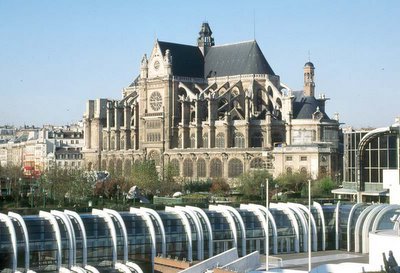 The church of St. Eustache, whose bell towers were never completed, as seen across the Jardin des Halles, with the Forum in the foreground.
The church of St. Eustache, whose bell towers were never completed, as seen across the Jardin des Halles, with the Forum in the foreground.
To the west, on your left, you can see the circular commodities exchange building, the Bourse de Commerce, where futures in wheat, flour, sugar and other goods are traded. The current building was erected in 1889.
Continue to St. Eustache. Just outside the church in the Place René Cassin is the striking stone sculpture l’écoute by Henri de Miller. The church itself was built between the 15th and 18th centuries and even though it represents an amalgam of architectural styles, the result (even without its bell towers) is glorious. At left is one of the church's architectural details. Today, seen from across the garden at nightfall, the church is lit to dramatic effect.
 St. Eustache by night.
St. Eustache by night.
 At the eastern end of the church, along the rue Rambuteau, the rue Montorgueil (seen at right) starts its northward run. Worth a side trip, this very old working-class street has recently gone upscale with the renovation of Les Halles. Old restaurants and marginal residential buildings have been gentrified into chic cafés and eateries and pricey apartments. The street was re-paved in the 1980s and retains just a bit of its old market-street charm.
At the eastern end of the church, along the rue Rambuteau, the rue Montorgueil (seen at right) starts its northward run. Worth a side trip, this very old working-class street has recently gone upscale with the renovation of Les Halles. Old restaurants and marginal residential buildings have been gentrified into chic cafés and eateries and pricey apartments. The street was re-paved in the 1980s and retains just a bit of its old market-street charm.
Continue eastward along the rue Rambuteau along the north side of the forum complex. Turn right into the rue Pierre Lescot, pass the main entrance to the forum/métro/RER complex on your right, and walk into the Square des Innocents at the rue Berger. In the center of this animated square is the Fontaine des Innocents, constructed in 1550. This square was a cemetery in the 12th century; the skeletal remains of those buried here were relocated in the late 18th century to make way for a fruit and vegetable market.
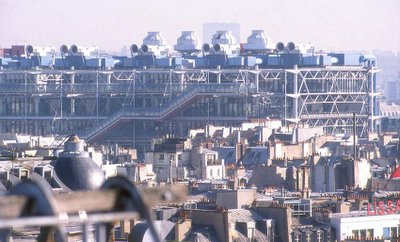
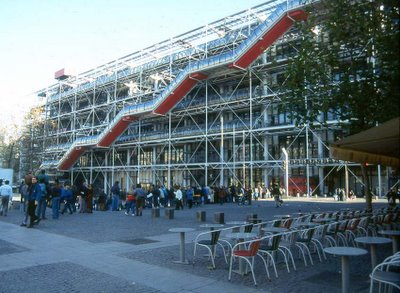 Top, The Pompidou Center, seen from the bell towers of Notre Dame Cathedral, rises above the Paris rooftops. Bottom, a ground-level view.
Top, The Pompidou Center, seen from the bell towers of Notre Dame Cathedral, rises above the Paris rooftops. Bottom, a ground-level view.
Turn left and walk eastward along the rue Berger, rue Aubry le Boucher and the rue St. Merri until you come to the vast Place Georges Pompidou in front of the Pompidou Center. Beginning in 1969, this neighborhood underwent a significant transformation. Its focus was to be the home of Paris’ center for modern/contemporary art. Richard Rogers and Renzo Piano designed the building to maximize flexible interior floor space by placing most of the mechanical and circulation systems around the exterior skin. The result is an impressive multicolored industrial-looking structure that was completed in 1977.
Whole blocks were rebuilt in the neighborhood, modernizing the housing stock and adding retail space. In some cases (especially along the rue Saint-Martin), historic façades were retained with new construction just behind.
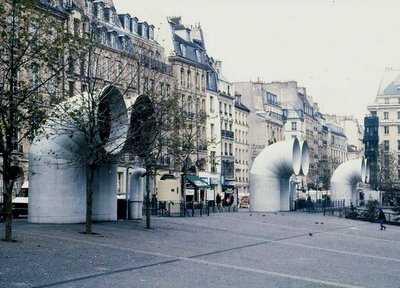 Giant funnels ventilate the parking garage beneath the public square in front of the Pompidou Center. The façades of the buildings here were preserved with new construction just behind.
Giant funnels ventilate the parking garage beneath the public square in front of the Pompidou Center. The façades of the buildings here were preserved with new construction just behind.
At the southern end of the Pompidou Center building, across the rue Merri, is the Place Igor Stravinsky with its whimsical animated fountain. Just beyond is the 15th century gothic church of St. Merri.

 Whimsy and color mark the Place Igor Stravinsky and provide an interesting transition from the modernism of the Pompdou Center to the gothic elements of the church of St. Merri.
Whimsy and color mark the Place Igor Stravinsky and provide an interesting transition from the modernism of the Pompdou Center to the gothic elements of the church of St. Merri.
Return to the Place Georges Pompidou and continue northward. Turn right onto the rue Rambuteau. Cross the rue du Temple and the rue des Archives. The street becomes the rue des Francs Bourgeois as you enter the Marais neighborhood, yet another fascinating part of the city that merits much more exploration if you have the time.
 The streets around the Forum des Halles and the Pompidou Center pulse with pedestrians. The myriad shops and cafés mixed with apartments and offices make for a vibrant city center.
The streets around the Forum des Halles and the Pompidou Center pulse with pedestrians. The myriad shops and cafés mixed with apartments and offices make for a vibrant city center.
Reclaimed from lowlands along the river (the word marais means swamp in French), this section of Paris became a fashionable location when wealthy citizens built their mansions here. After the French Revolution, the upper classes left the neighborhood and it declined until the early 1960s. Then, the government stepped in to preserve many of the historical buildings and a revitalization of the neighborhood got under way.
Today the Marais is home to museums (the Picasso Museum in the Hôtel Salé, the Kwok On Museum of Asian theater on the rue des Francs Bourgeois, and the museum of Paris history in the Hôtel Carnavalet are among them), galleries, boutiques, restaurants, and pricey residential real estate. Gay restaurants, hotels, and cafés can be found in the streets along the rue Vieille du Temple, and the Jewish quarter thrives around the rue de Rosiers. In the rue du Bourg Tibourg is Mariage Frères, a large tea shop with its own exhibits on the history of tea.
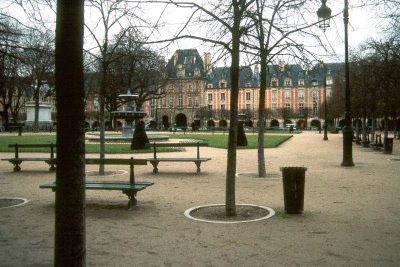 The Place des Vosges.
The Place des Vosges.
 Continue past the shops along the rue des Francs Bourgeois for several blocks and enter the Place des Vosges. Built during the 16th and 17th centuries in the popular Italian Renaissance style, the square was originally called Place Royale. Its houses, nine on each side, were built symmetrically and were the homes of Paris aristocrats. On the northwest corner of the square, under the arcades, is the café Ma Bourgogne, a wonderful place to sit and enjoy breakfast or sip a coffee. The writer Victor Hugo lived in one of the houses on the opposite corner of the place in the mid 19th century.
Continue past the shops along the rue des Francs Bourgeois for several blocks and enter the Place des Vosges. Built during the 16th and 17th centuries in the popular Italian Renaissance style, the square was originally called Place Royale. Its houses, nine on each side, were built symmetrically and were the homes of Paris aristocrats. On the northwest corner of the square, under the arcades, is the café Ma Bourgogne, a wonderful place to sit and enjoy breakfast or sip a coffee. The writer Victor Hugo lived in one of the houses on the opposite corner of the place in the mid 19th century.
Exit the Place des Vosges on the south side, through the Pavillon du Roi into the rue de Birague. At the rue St. Antoine, you can either turn right and make your way back toward Les Halles, or turn left and head to the Place de la Bastille. At right, the Bastille column, above left, a café on the rue St. Antoine.
 The church of St. Eustache, whose bell towers were never completed, as seen across the Jardin des Halles, with the Forum in the foreground.
The church of St. Eustache, whose bell towers were never completed, as seen across the Jardin des Halles, with the Forum in the foreground.To the west, on your left, you can see the circular commodities exchange building, the Bourse de Commerce, where futures in wheat, flour, sugar and other goods are traded. The current building was erected in 1889.
Continue to St. Eustache. Just outside the church in the Place René Cassin is the striking stone sculpture l’écoute by Henri de Miller. The church itself was built between the 15th and 18th centuries and even though it represents an amalgam of architectural styles, the result (even without its bell towers) is glorious. At left is one of the church's architectural details. Today, seen from across the garden at nightfall, the church is lit to dramatic effect.
 St. Eustache by night.
St. Eustache by night. At the eastern end of the church, along the rue Rambuteau, the rue Montorgueil (seen at right) starts its northward run. Worth a side trip, this very old working-class street has recently gone upscale with the renovation of Les Halles. Old restaurants and marginal residential buildings have been gentrified into chic cafés and eateries and pricey apartments. The street was re-paved in the 1980s and retains just a bit of its old market-street charm.
At the eastern end of the church, along the rue Rambuteau, the rue Montorgueil (seen at right) starts its northward run. Worth a side trip, this very old working-class street has recently gone upscale with the renovation of Les Halles. Old restaurants and marginal residential buildings have been gentrified into chic cafés and eateries and pricey apartments. The street was re-paved in the 1980s and retains just a bit of its old market-street charm.Continue eastward along the rue Rambuteau along the north side of the forum complex. Turn right into the rue Pierre Lescot, pass the main entrance to the forum/métro/RER complex on your right, and walk into the Square des Innocents at the rue Berger. In the center of this animated square is the Fontaine des Innocents, constructed in 1550. This square was a cemetery in the 12th century; the skeletal remains of those buried here were relocated in the late 18th century to make way for a fruit and vegetable market.

 Top, The Pompidou Center, seen from the bell towers of Notre Dame Cathedral, rises above the Paris rooftops. Bottom, a ground-level view.
Top, The Pompidou Center, seen from the bell towers of Notre Dame Cathedral, rises above the Paris rooftops. Bottom, a ground-level view.Turn left and walk eastward along the rue Berger, rue Aubry le Boucher and the rue St. Merri until you come to the vast Place Georges Pompidou in front of the Pompidou Center. Beginning in 1969, this neighborhood underwent a significant transformation. Its focus was to be the home of Paris’ center for modern/contemporary art. Richard Rogers and Renzo Piano designed the building to maximize flexible interior floor space by placing most of the mechanical and circulation systems around the exterior skin. The result is an impressive multicolored industrial-looking structure that was completed in 1977.
Whole blocks were rebuilt in the neighborhood, modernizing the housing stock and adding retail space. In some cases (especially along the rue Saint-Martin), historic façades were retained with new construction just behind.
 Giant funnels ventilate the parking garage beneath the public square in front of the Pompidou Center. The façades of the buildings here were preserved with new construction just behind.
Giant funnels ventilate the parking garage beneath the public square in front of the Pompidou Center. The façades of the buildings here were preserved with new construction just behind.At the southern end of the Pompidou Center building, across the rue Merri, is the Place Igor Stravinsky with its whimsical animated fountain. Just beyond is the 15th century gothic church of St. Merri.

 Whimsy and color mark the Place Igor Stravinsky and provide an interesting transition from the modernism of the Pompdou Center to the gothic elements of the church of St. Merri.
Whimsy and color mark the Place Igor Stravinsky and provide an interesting transition from the modernism of the Pompdou Center to the gothic elements of the church of St. Merri.Return to the Place Georges Pompidou and continue northward. Turn right onto the rue Rambuteau. Cross the rue du Temple and the rue des Archives. The street becomes the rue des Francs Bourgeois as you enter the Marais neighborhood, yet another fascinating part of the city that merits much more exploration if you have the time.
 The streets around the Forum des Halles and the Pompidou Center pulse with pedestrians. The myriad shops and cafés mixed with apartments and offices make for a vibrant city center.
The streets around the Forum des Halles and the Pompidou Center pulse with pedestrians. The myriad shops and cafés mixed with apartments and offices make for a vibrant city center.Reclaimed from lowlands along the river (the word marais means swamp in French), this section of Paris became a fashionable location when wealthy citizens built their mansions here. After the French Revolution, the upper classes left the neighborhood and it declined until the early 1960s. Then, the government stepped in to preserve many of the historical buildings and a revitalization of the neighborhood got under way.
Today the Marais is home to museums (the Picasso Museum in the Hôtel Salé, the Kwok On Museum of Asian theater on the rue des Francs Bourgeois, and the museum of Paris history in the Hôtel Carnavalet are among them), galleries, boutiques, restaurants, and pricey residential real estate. Gay restaurants, hotels, and cafés can be found in the streets along the rue Vieille du Temple, and the Jewish quarter thrives around the rue de Rosiers. In the rue du Bourg Tibourg is Mariage Frères, a large tea shop with its own exhibits on the history of tea.
 The Place des Vosges.
The Place des Vosges. Continue past the shops along the rue des Francs Bourgeois for several blocks and enter the Place des Vosges. Built during the 16th and 17th centuries in the popular Italian Renaissance style, the square was originally called Place Royale. Its houses, nine on each side, were built symmetrically and were the homes of Paris aristocrats. On the northwest corner of the square, under the arcades, is the café Ma Bourgogne, a wonderful place to sit and enjoy breakfast or sip a coffee. The writer Victor Hugo lived in one of the houses on the opposite corner of the place in the mid 19th century.
Continue past the shops along the rue des Francs Bourgeois for several blocks and enter the Place des Vosges. Built during the 16th and 17th centuries in the popular Italian Renaissance style, the square was originally called Place Royale. Its houses, nine on each side, were built symmetrically and were the homes of Paris aristocrats. On the northwest corner of the square, under the arcades, is the café Ma Bourgogne, a wonderful place to sit and enjoy breakfast or sip a coffee. The writer Victor Hugo lived in one of the houses on the opposite corner of the place in the mid 19th century.The next tour will take us through the Latin Quarter. Look for it toward the end of next week!







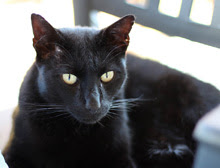


No comments:
Post a Comment
Tell me what you think!